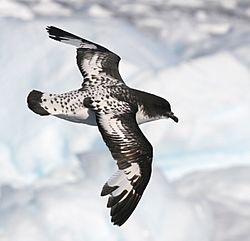Procellariiformes facts for kids
Procellariiformes are a group of amazing seabirds. This order of birds includes four main families: the albatrosses, petrels and shearwaters, storm petrels, and diving petrels. You can find these birds all over the world's oceans. The greatest number of different types live around New Zealand.
Quick facts for kids ProcellariiformesTemporal range: Eocene - Present
|
|
|---|---|
 |
|
| Cape Petrel Daption capense | |
| Scientific classification | |
| Kingdom: | |
| Phylum: | |
| Class: | |
| Infraclass: | |
| Superorder: |
Neoaves
|
| Order: |
Procellariiformes
Fürbringer, 1888
|
| Families | |
|
Procellariidae |
|
About Procellariiformes
These birds have been around for a very long time, since the Eocene period. They are known for their unique tube-like nostrils, which help them smell food from far away. They also have a special gland that helps them get rid of extra salt from the seawater they drink. This allows them to live far out at sea.
Life Cycle and Reproduction
Procellariiformes usually lay only one egg at a time. They also typically nest only once a year. However, the biggest albatrosses might only nest every two years because raising their chick takes a very long time.
Both the mother and father bird help to warm the egg (this is called incubation). They also take care of the baby bird, called a chick. Their eggs take a long time to hatch compared to other birds. The chicks also take a long time to grow up and learn to fly (this is called fledging). Once a chick can fly, its parents do not take care of it anymore.
Images for kids
-
Pterodroma macroptera from Godman's Monograph of the Petrels, 1907–1910
-
The southern royal albatross is one of the largest of the Procellariiformes.
-
The white-faced storm petrel moves across the water's surface in a series of bounding leaps.
-
Christmas shearwaters are one of the surface-nesting tropical procellariiforms.
-
Wandering albatrosses performing their mating dances on the Kerguelen Islands
-
A semi-precocial wedge-tailed shearwater chick with guarding parent
-
A Laysan albatross feeds its chick. The parent pumps food from a modified foregut, the proventriculus, and the chick catches the meal in its lower mandible.
-
The Albatross about my Neck was Hung: 1896 etching by William Strang illustrating Coleridge's 1798 poem The Rime of the Ancient Mariner
-
A tail-piece engraving in Bewick's A History of British Birds, showing men exploiting birds nesting on sea cliffs, 1804
-
The poorly known New Zealand storm petrel was considered extinct for 150 years before being rediscovered in 2003.
-
Black-browed albatross hooked on a long-line
See also
 In Spanish: Procellariiformes para niños
In Spanish: Procellariiformes para niños












